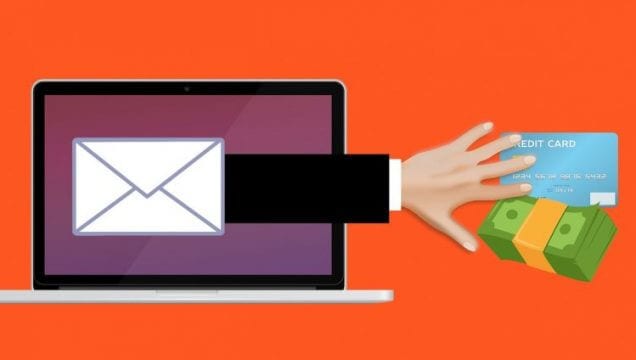What Are Phishing Emails and How To Prevent It?
According to Wikipedia, “Phishing is the fraudulent attempt to obtain sensitive information such as usernames, passwords and credit card details by disguising oneself as a trustworthy entity in an electronic communication. Typically carried out by email spoofing or instant messaging,”
Here, you are directed to a fake website to enter your important credentials like passwords and login details. All this is done to cause you economic loss and steal your sensitive data. In this quick guide, we have discussed what are phishing emails, what are its signs, and how to prevent it?
What Is a Phishing Scam?
Phishing is one of the most common online scams, in which hackers attempt to extract personal information or unleash malware via fraudulent emails. Typically, emails are created to look like they come from a legitimate company, like a bank. They often include dangerous links or infected attachments.
If you click on a link in one of these phishing emails, you’ll often be prompted to fill out personal info or a network username and password on a website that looks like a company’s website.
These scams are referred to as “phishing” because hackers are “fishing” for your sensitive information or trying to “lure” you into a trap. Phishing scams are known as social engineering cons because they rely on human error to work. For this reason, they’re one of the most popular scams used by hackers.
Since hackers are banking on your likelihood to make a mistake, it’s essential to know how to spot a phishing scam when you see one.
6 Signs of a Phishing Email
How can you tell if an email is fraudulent? There are usually 6 big signs to look out for.
#1 Misspelled Domain Name This one seems fairly obvious but unfortunately, many people fall for it. Most of us often don’t check the domain name of a sender right away, but it can be the biggest tip-off that it’s a phishing scam. Hackers can easily purchase domain names meant to resemble legitimate ones at first glance, so always be wary of this.
You can see the domain name by hovering over the “from” address. If the domain name contains numbers, like @paypal45.com instead of just @paypal.com, that should raise some alarm bells. Sometimes variations are more subtle than that though. You might see a legitimate company’s name misspelt slightly, or written in a way to fool you if you glance over it quickly. Always look at the domain name from a suspicious sender, and search for a company’s correct domain name on Google when in doubt.
#2 Poorly Written If the email contains grammatical errors or unusual phrasing that’s another sign it might be a scam. That’s not to say you should delete every email you receive with a mistake in it – everybody makes typos. However if the mistakes seem more like they were made by a non-native English speaker (many hackers don’t speak English as their first language), or the language is inconsistent with previous emails you’ve received from this sender, be suspicious.
Official email communication from banks or other institutions is typically saved as templates, which are written, edited, and proofread several times before being sent out to clients. A small typo, like a “g” in place of an “f”, isn’t a huge problem since these keys sit right next to each other. A glaring mistake, like a company asking urgently for an update to your “information” rather than “information”, is an error typical of non-native English speakers. Something like this should be a big tip-off.
#3 Calls for Urgent Action Phishing emails try to establish a sense of urgency. They tell you that you must act quickly on something, or something else bad might result. If you receive an email with words like “your account will be closed” out of nowhere, be cautious. Hackers are trying to draw on your initial concern when reading phrases like that to entice you to click on a fraudulent link.
If you get an email with urgent language like this and you’re concerned, always contact your bank or other institution separately and enquire about updating your info. Some hackers go beyond banks or companies, though, claiming to be from government agencies. They threaten legal action if you don’t respond right away. However, government agencies don’t send emails as their initial form of communication in these cases.
#4 Fake Links Phishing scams often involve redirecting users to a dangerous website via a link in an email. They might hide the URL of the website in a button or hyperlinked text. Before clicking on a link in a suspicious or unexpected email, hover your mouse over the link to display the full URL at the bottom of your browser. Here you’ll see the full web address, which you can usually tell is a bogus link.
Another thing to look out for in suspicious URLs is the order of the URL components. DNS naming structure follows a standard: child domain [dot] full domain [dot] com. So something like info.companyname.com would be a legitimate address taking you to that company website’s info page. Hackers will use structures like full domain [dot] malicious link [dot] com. They place the bogus link after the legitimate company name: companyname.boguslink.com. Learn to scrutinize URL links carefully, so you can avoid clicking on malicious links sent to your email.
#5 Asks for Personal Info Always be wary of emails that ask for personal information, even if they appear to be from a trusted sender. Hackers go to great lengths to make emails appear legitimate. If you suspect it’s fake, don’t click any of the links in the email. Instead, go to the organisation’s website and contact them directly, asking if they need to confirm your personal info.
For this very reason, many institutions won’t ask you to confirm sensitive information like bank numbers, NRIC, or login credentials over email. Always give personal info like this through secure means, such as in a password-protected online portal on the company’s website. Some organisations will send you a link via email to log in on to their secure portal. If you don’t trust it, use tip #4 to inspect it for authenticity before clicking. You should be able to access their secure login area directly from their website as well.
#6 Suspicious Attachment Hackers will send infected attachments via email that when opened unleash malware onto your computer. Unsolicited email attachments should always make you wary. It’s advised to never open an email attachment unless you are 100% confident the message is from a legitimate sender. In addition, legitimate companies will typically not send you attachments but instead ask you to download forms directly from their website.
High-risk attachments to keep an eye out for are .exe, .scr, and .zip files. The chances the attachment contains malware increases with uncommon file types like these. For most of us, opening the attachment right away might seem natural – especially if it’s an unsolicited, puzzling phishing email. Your instinct might be to click on the attachment to have more info. But this kind of thinking is what hackers are counting on when they send scam emails.
Final Thoughts Remaining vigilant when it comes to your email is the best way to prevent phishing hacks. We are often in a hurry when we comb through our inbox, but this is an easy way to get taken in by a scam. Always take an extra second to review unexpected emails or messages from unknown senders – trust us, you’ll be glad you did.
Author Bio
David Share – Director at Amazing Support has held positions as Operations Director and Head of IT in legal and professional firms for more than 10 years. He is a Director and co-owner of Amazing Support, an Award-Winning, Microsoft Silver & Cyber Essentials accredited specialist managed IT Support and Cyber Security Company.
Popular Post
Recent Post
How to Access Microsoft’s New Emoji in Windows 11
Ever since the public introduction of Windows 11, we’ve seen it gradually mature further towards the operating system that it is presently. Microsoft is working hard to give Windows 11 a next-generation experience, as well as new updates, are being released as a result. So now, emoticons in Windows 11 have been updated. Microsoft later […]
How to Transfer iPhone Photos to Your Mac (8 Easy Solutions)
Have you clicked a stellar image with your iPhone and now want to upload it on your website or edit it? Then, you can easily transfer your iPhone photos to your Mac to edit them with robust MacOS editing tools and further upload them on the web. Transferring photos from iPhone to Mac can save […]
How to Set Up and Use iCloud on Mac
If you haven’t set up iCloud on your Mac yet, do it now. iCloud is a powerful cloud storage service for Apple users that allow people to back up and synchronize email, photos, contacts, and other files across various devices. iCloud service was introduced in 2011, and it supports MacOS 10.7 or higher. As of […]
How to Create a Guest User Account on Mac
Computers are a very personal thing today. They store all your private documents, photos, videos, and other data. Thus, giving your Mac password to someone else is never a good idea. But what if you have to share your Mac with a colleague or friend for some reason? Sharing Mac’s user password can jeopardize your […]
How to Set Up a New Mac in a Few Minutes
Have you bought or received a brand new Mac computer? Then, you must be on the seventh cloud. Your Mac will open a pandora of several graphics-rich apps and features for you. If you are moving from Windows to Mac for the first time, the change will be really dramatic. At first, all the interfaces […]
How to Clear Browsing History
Are you concerned about what others could see if they use your web browser? Is your browser history clogging up your device and slowing things down? A list of the website pages you have viewed is stored in every web browser. You can remove this listing easily. It will clean your browser history and erase all […]
The Definitive Guide to Managing Your Mac’s Storage Space
Are you struggling with low storage space on Mac? Wondering what is taking up so much space?You are at the right place. Here we will discuss how to reclaim space on Mac. Gone are those days when you used Mac machines only for p rofessional purposes. Now, everything from downloading movies to streaming content, saving […]
Is New World a modern-day RuneScape?
Amazon Game Studios has released an MMO nearly identical to RuneScape, but with a new look, a better PvP system, and a lot more money. Allow me to clarify. New World is influential ‘RuneScape only it’s not RuneScape.’ New World vs. RuneScape 3 New World digs deep into the well of memories and pulls out […]
How To Set Up Voicemail on iPhone 11
Although accessing voicemail is extremely beneficial to you, users should understand how to set up voicemail on their iPhone 11. You can remove, categorize, and play the voicemails from the easy menu. Once you are occupied or unable to pick up the phone, this program will give you info in the style of an audio […]
Best Virtual Machine Software for Windows 10/11 in 2024
A virtual machine software, often known as VM software, is an application that replicates a virtual computer platform. A VM is formed on a computer’s underlying operating platform, and the VM application generates virtual CPUs, disks, memory, network interfaces, and other devices. Virtual machine solutions are becoming more popular because of the flexibility and efficiency […]






















